
CHILLIES (Whole & Grounded)
We are one of the leading supplier of fine quality red chilly, which is famous for its aroma and rich red colour.The red chilly brought in our firm is kept in appropriate conditions within our warehouse so as to maintain its freshness, crispiness and its distinct smell. Chosen from the best of farms located in selected regions. We are offering different kind of chilly grounded / powder, chilly flakes (Kibbled-Pizza Cut) in assorted heat value (Schouville) & color index (Asta).

We offer all Indian varieties of red chillies like 334, S-4, S7(Bird Eye & Semibird Eye), S9 (Round-Mundu). Also known as red pepper with different schouville values & Asta colour. Red chillies are used in different cuisines to make the food more delicious and tasty.
Chilli is the dried ripe fruit of the genus Capsicum. Capsicum annum is an annual sub –shrub, the flowers of which are borne singly and fruits usually pendent, which provide red peppers, cayenne, paprika and chillies and sweet pepper (bell pepper) a mild form with large inflated fruits.
Capsicum frutescence is a perennial chilly with small sized pods
which are highly pungent. It is commonly known as ‘bird chilly’ and
‘Tabasco’.
| Botanical name | Family name | Commercial part |
| Capsicum annum L Capsicum frutescens L |
Solanaceae | Green as well as ripe and dried pod (fruit) |
TURMERIC
The whole turmeric is a tuberous rhizome, with a rough, segmented skin. The rhizome is yellowish-brown with a dull orange interior that looks bright yellow when powdered. Our high quality turmeric acts as a mild digestive, being aromatic, a stimulant and a carminative. An ointment base on the spice is used as an antiseptic, its water is used as a cosmetic applied to impart a golden glow to the complexion. We are specialized in turmeric of assorted varieties of curcumin value.

Turmeric, The primary rhizomes, round in shape are called 'bulbs', while the thin, long secondary rhizomes are 'fingers'. It has a characterized fragrance, peppery aroma & it’s slightly bitter in taste with a musky flavor.
Origin and Distribution
It is a native of India. Apart from India, it is cultivated in Pakistan, Malaysia,
Myanmar, Vietnam, Thailand, Philippines, Japan, Korea, China, Sri Lanka, Nepal, East
& West Africa, South Pacific Islands, Malagasy, Caribbean Islands and Central
America. In India, it is cultivated in the States of Andhra Pradesh, Maharashtra,
Orissa, Tamil Nadu, Karnataka and Kerala.
Turmeric is a tropical crop cultivated from sea level to 1200 meter MSL. It grows in
light black, black clayey loams and red soils in irrigated and rainfed conditions.
The crop cannot stand water logging or alkalinity
|
Botanical name |
Family name
|
Commercial part
|
|
Curcuma longa L.
|
Zingiberaceae
|
Rhizome or underground stem
|
CURRY POWDER
Curry powder is a mixture of spices of widely varying composition based on Indian cuisine. Curry powder, and the contemporary English use of the word curry are Western inventions and do not reflect any specific Indian food. The word curry is widely believed to be a bastardization of the Tamil word kari[1], meaning something like sauce, but it may also be derived from the French cuire[2]. In the Western world Curry Powder mixtures tend to have a fairly standardized taste, though a great variety of spice mixtures are used in Indian cuisine.
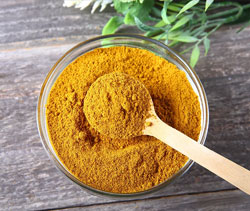
Curry powder was largely popularized during the nineteenth and twentieth centuries
through the mass exportation of the condiment to the western table - throughout
Europe, North and South America. Still, curry powder did not become standardized, as
many of the original blends of curry powder were still available throughout the
world. The late 60s and early 70s saw a large increase of Indian food consumption in
the west and internationally. This led to an increase of Indian restaurants
throughout the world. The tradition of keeping special blends of curry powder simply
became uneconomical, and curry powder became increasingly standardized outside
India.
Indian cooks often have readier access to a variety of fresh spices than their
foreign counterparts. Some curry cooks will have their own specific mixtures for
different recipes. These are often passed down from parent to child.
CORIANDER SEEDS
Among one of the first spices used by mankind,
coriander seeds, is the seed of coriandrum sativum, which belongs to the
parsley family. The coriander seeds are almost oval in shape and greenish to
yellowish in color.
It is a fragrant spice, with a mild, distinctive taste. It is widely used as
a condiment in foods, beverages, marinades, desserts and sweet pastries and
American cigarettes. It is also valued for its medicinal properties.
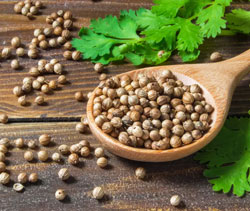
This fragrant spice is known for its medicinal properties and used as a condiments in curries; as fresh leaves for garnishing of curries, and in chutney as an appetiser.
Origin and Distribution
It is a native of Mediterranean and commercially produced in India, Morocco, Russia,
East European countries, France, Central America, Mexico, and USA. Coriander is a
tropical crop and can be successfully cultivated as a rabi season crop in an area
free from severe frost during February when the crop flowers and sets its seeds
|
Botanical name
|
Family name | Commercial part |
| Coriandrum sativam L. | Apiaceae | Leaf and seed |
FENUGREEK SEEDS
Fenugreek seed whole consist of dried ripe seed of trigonella foenumgraecum. The colour is carramel to light brownish-yellow. Odour and taste are typical, a bit of cellery and bitter. Free from foregn odour and taste, such as mustiness or rancidity . Fenugreek has a strong, pleasant and quite peculiar odour. Fenugreek seed is the ripe fruit of an annual herb. This robust herb has light green leaves, is 30-60 cm tall and produces slender, beaked pods, 10-15 cm long, each pod contains 10-20 small hard yellowish brown seeds, which are smooth and oblong, about 3mm long, each grooved across one corner, giving them a hooked appearance.
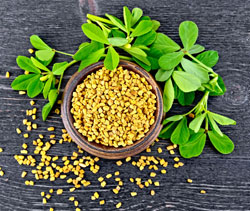
Origin and Distribution
Fenugreek is a native of South Eastern Europe and West Asia, now cultivated in
India, Argentina, Egypt and Mediterranean countries (Southern France, Morocco and
Lebanon). In India it is grown extensively in Rajasthan, Gujarat, Madhya Pradesh,
Uttar Pradesh, Maharashtra and Punjab.
It is a cold season crop and is fairly tolerant to frost and very low temperature. It is best suited to tracts of moderate to low rainfall and is sown in all types of soil but perform better in loam and clayey loam with proper drainage. It can also be grown on black cotton soils.
|
Botanical name
|
Family name
|
Commercial part
|
|
Trigonella foenum-graecum L.
|
Fabaceae
|
Fruit
|
FENNEL SEEDS
Fennel seeds are the dried fruit of Foeniculum vulgare, which belongs to the parsley family. It is oval in shape and green or yellowish brown in color. It has a slightly sweet flavor. It is a biennial, aromatic, stout, glabrous, 1.5 to 1.8 mtr high. The ripe fruit (seed) is small, oblong, cylindrical, 6.8mm long, straight or slightly curved, greenish yellow, deeply furrowed, 5 ridged and having agreeable aroma.
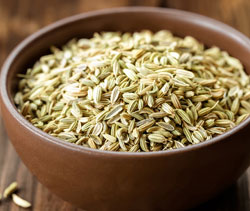
Origin and Distribution
It is a native of Europe and Asia Minor. It is cultivated extensively in Northern
India as a cold weather crop. It comes up well in fairly mild climate. The dry and
cold weather favours high seed production. Prolonged cloudy weather at the time of
flowering is conducive to diseases and pests.
|
Botanical name
|
Family name
|
Commercial part
|
|
Foeniculum vulgare Miller
|
Apiaceae
|
Fruit
|
DILL SEEDS
Dill is the dried fruit of the herb anethum graveolens, which belongs to the parsley family. Dill seeds are oval-shaped, soft and fluffy and has a pungent and aromatic flavor. Dill seeds have been used since ancient times. Dill is a herbaceous annual with pinnately divided leaves. The ripe, light brown seeds emit an aromatic odour. The leaves have pleasant aromatic odour and warm taste. Both seeds and leaves are valued as spice.
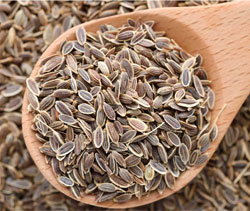
Origin and Distribution
European Dill (Anetheum graveolens) is indigenous to Europe and is cultivated in
England, Germany, Romania, Turkey, USA and Russia. The Indian dill (Anetheum sowa),
a native of Northern India is bolder than the European dill. It is cultivated as a
cold weather crop in many parts of India.
|
Botanical name
|
Family name
|
Commercial part
|
|
Foeniculum vulgare Miller
|
Apiaceae
|
Fruit
|
CUMIN SEEDS
Cumin seeds are the seeds of cuminum cyminum, which belongs to the parsley family. It is pale green in color and elliptical in shape with deep furrows. Cumin seeds has a penetrating flavour and aroma. Cumin is the dried, white fruit with greyish brown colour of a small slender annual herb. The surface of the fruit has 5 primary ridges, alternatively has 4 less distinct secondary ridges bearing numerous short hairs. The plant is 15 to 50 cm high. The aromatic seed like fruit is elongated, ovoid, 3 to 6 mm long, slightly bitter and has a warm flavour. The flowers are white or rose coloured in small umbels.
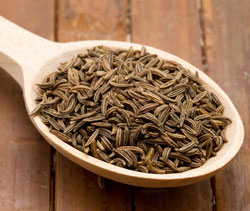
Origin and Distribution
Cumin is indigenous to Northern Egypt, Syria, the Mediterranean region, Iran and
India. It is also cultivated in Mexico, China, Sicily and Malta. Cumin is a tropical
plant and is cultivated as a rabi crop in areas where atmospheric humidity during
February-March is low.
|
Botanical name |
Family name
|
Commercial part
|
|
Anethum graveoluns L.
|
Apiaceae
|
Fruit
|
BLACK PEPPER
We are exporting high quality Black pepper in bulk quality as per client requirements. The Black pepper that we export is hygienically packaged and is free from impurities. Our customers can avail Black pepper from us in packs of different quantities as per their requirements. Black Pepper is the dried mature berries of Piper Nigrum grown in South India, garbled, dark brown to dark black in colour nearly globular, with a wrinkled surface.
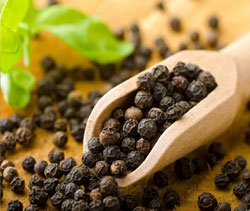
Light berry contents to be tested by floatation method in alcohol or methylated spirit of 0.80 to 0.82 specific gravity at room temperature (around 25°C).
| Botanical name | Family name |
| Piper nigrum Linn | Piperaceae |
AJWAIN
Ajwain is very aromatic but less subtle in taste. It is slightly bitter, pungent and strong. Even a small amount of ajwain dominates the taste of a dish. In India, ajwain is never used raw, but is either roasted or fried in ghee, which is done to develop a stronger and more prominent aroma. It is primary used as a digestive aid and ant emetic. We offer ajwain that is grown under trained farmers, which is used for culinary as well as medicinal purposes.
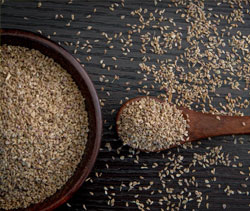
Ajwain has a specific aroma and taste to add in wide variety of foods. Ajwain also has excellent preservative and medicinal properties.
| Botanical name | Family name |
| Trachyspermum copticum | Umbelliferae/Apiaceae |
CARDAMOM
Cardamom of commerce is the dried ripe fruit (capsules of cardamom plant) often referred as the “Queen of Spices” because of its very pleasant aroma and taste. Cardamom is a perennial, herbaceous, rhizomatous plant. Based on the nature of panicles, three varieties are recognized viz. Malabar with prostrate panicle, Mysore with erect panicle, and Vazhukka with semi erect panicle.

Plants are of medium size (2 to 3 mtr height) with pubescent leaves (on the dorsal side) and fruits globose in the case of Malabar, whereas plant robust (3 to 4 mtr height) with leaves glabrous on both sides with ovoid capsules in the case of Mysore. Vazhukka variety is a mix of both the above in physical characteristics.
| Botanical name | Family name | Commercial part |
| Elettaria cardamomum Maton | Zingiberaceae | Fruit (Capsule) |
NUTMEG
In Indian cuisine, nutmeg is used in many sweet as well as savoury dishes (predominantly in Mughlai cuisine). It is known as Jaiphal in most parts of India and as Jatipatri and Jathi seed in Kerala. It may also be used in small quantities in garam masala. Ground nutmeg is also smoked in India. Serves as a tonic for the heart and brains.
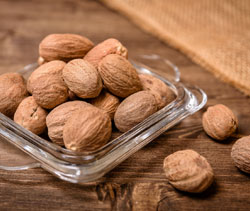
| Botanical name | Family name |
| Myristica fragrans (HOUTT.) | N.O. Myristicaceae |
CELERY SEEDS
Celery is valuable in weight-loss diets, where it provides low-calorie dietary fiber bulk. Celery contains androstenone. [4] Bergapten in the seeds can increase photosensitivity, so the use of essential oil externally in bright sunshine should be avoided. The oil and large doses of seeds should be avoided during pregnancy: they can act as a uterine stimulant. Seeds intended for cultivation are not suitable for eating as they are often treated with fungicides.
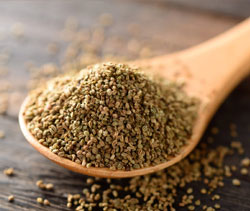
There is a common belief that celery is so difficult for humans to digest, that it has negative calories because human digestion burns more calories than can be extracted. [5] Celery seeds are also a great source of calcium, and are regarded as a good alternative to animal products.
| Botanical name | Family name |
| Apium graveolens dulce | Apiaceae |
MUSTARD SEEDS (Yellow & Brown)
Mustard is a versatile seed, it is used in umpteen number of ways, the seeds can be crushed to form a paste that is mixed with water to form condiment. It can be dried and crushed to form a powder, which is further processed to form mustard sauce. There are two types of mustards available, one is the black variety and the other is the most popularly used, the yellow one.
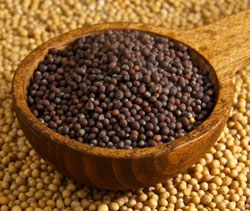
We closely monitor the mustard seeds that we plan to pick out for supply and keep them under strict vigil, ever since they start germinating, we also create artificial cold and moist conditions to facilitate proper germination so that only high quality mustard is produced.
| Botanical name | Family name |
| Brassica Alba, Brassica Nigra, Sinapsis Alba | Cruciferae |
NIGELLA SEEDS
We also export NIGELLA SEEDS. Nigella seeds are small, matte-black grains with a rough surface and an oily white interior. They are roughly triangulate, 1 1/2 - 3 mm (1/16 to 1/8 in ) long. They are similar to onion seeds. The seeds have little bouquet, though when they are rubbed they give off an aroma reminiscent of oregano. Slightly bitter and peppery with a crunchy texture.
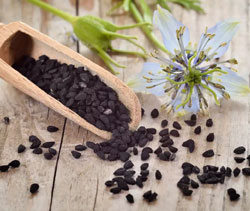
| Botanical name | Family name |
| Nigella Sativa | Ranunculaceae |
ANNATTO SEEDS
Annatto is used both as a spice and a dyestuff. It may be better known to Mexican and Latin markets as achiote or in the Philippines as atsuwete or achuete. In the West it used to colour confectionery, butter, smoked fish and cheeses like Cheshire, Leicester, Edam and Muenster. It provides a bright and exotic appearance for many kinds of dishes.
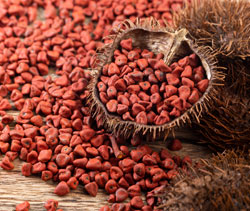
Annatto seeds are brick red, triangular in shape, 3 - 5 mm (1/8” - 3/16”). The seeds are available whole and can often be purchased in a block or paste form at Latin American markets. Bouquet: slightly peppery with a hint of nutmeg Flavour: slightly sweet and peppery.
| Botanical name | Family name |
| Bixa orellana | Bixa Family |
GALANGAL ROOTS
It is used in various oriental cuisines. Though it is related to and resembles ginger, there is little similarity in taste. In its raw form, galangal has a citrusy, earthy aroma, with hints of pine and soap in the flavor. It is available as a whole root, cut or powdered. The whole fresh root is very hard, and slicing it requires a sharp knife.
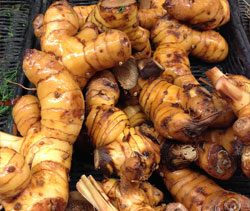
| Botanical name | Family name |
| Alpinia Galanga | Zingiberaceae |
We also supply Mix container of Spices, Grains, Oil Seeds and Other Agricultural Commodities as per customer's requirements.
